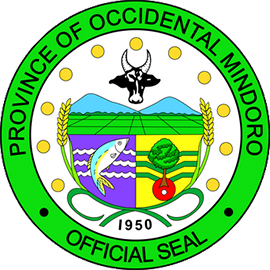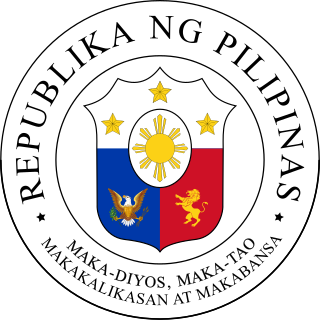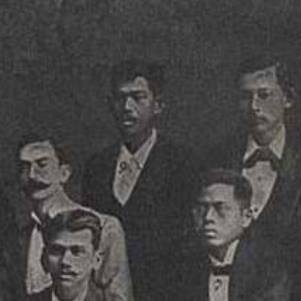
The national flag of the Philippines is a horizontal bicolor flag with equal bands of royal blue and crimson red, with a white, equilateral triangle at the hoist. In the center of the triangle is a golden-yellow sun with eight primary rays, each representing a province. At each vertex of the triangle is a five-pointed, golden-yellow star, each of which representing one of the country's three main island groups—Luzon, Visayas and Mindanao. The white triangle at the flag represents liberty, equality, and fraternity. A unique feature of this flag is its usage to indicate a state of war if it is displayed with the red side on top, which is effectively achieved by flipping the flag upside-down.

The Philippine Revolution ; (Filipino: Himagsikang Pilipino / Rebolusyong Pilipino, called the Tagalog War by the Spanish, was a revolution, a civil war and subsequent conflict fought between the people and insurgents of the Philippines and the Spanish colonial authorities of the Spanish East Indies, under the Spanish Empire.

Norzagaray, officially the Municipality of Norzagaray, is a 1st class municipality in the province of Bulacan, Philippines. According to the 2020 census, it has a population of 136,064 people.

San Miguel, officially the Municipality of San Miguel, is a 1st class municipality in the province of Bulacan, Philippines. According to the 2020 census, it has a population of 172,073 people.
The Philippines is divided into four levels of administrative divisions with the lower three being defined in the Local Government Code of 1991 as local government units (LGUs). They are, from the highest to the lowest:
- Regions, mostly used to organize national services. Of the 17 regions, only one – the Bangsamoro Autonomous Region in Muslim Mindanao – has an elected government to which the central government has devolved competencies.
- Provinces, independent cities, and one independent municipality (Pateros).
- Component cities and municipalities within a province.
- Barangays within a city or municipality.

The legislative districts of San Jose del Monte are the representations of the component city of San Jose del Monte in the Congress of the Philippines. The city is currently represented in the lower house of the Congress through its lone congressional district.

The legislative districts of Bulacan are the representations of the province of Bulacan in the various national legislatures of the Philippines. The province is currently represented in the lower house of the Congress of the Philippines through its first, second, third, fourth, fifth and sixth congressional districts.
The legislative districts of Laguna are the representations of the province of Laguna in the various national legislatures of the Philippines. The province is currently represented in the lower house of the Congress of the Philippines through its first, second, third, and fourth congressional districts.

The Pact of Biak-na-Bato, signed on December 15, 1897, created a truce between Spanish colonial Governor-General Fernando Primo de Rivera and the revolutionary leader Emilio Aguinaldo to end the Philippine Revolution. Aguinaldo and his fellow revolutionaries were given amnesty and monetary indemnity by the Spanish Government, in return for which the revolutionary government would go into exile in Hong Kong. Aguinaldo had decided to use the money to purchase advance firearms and ammunition later on return to the archipelago.

Mariano Trías y Closas is considered to be the first de facto Philippine Vice President of that revolutionary government established at the Tejeros Convention - an assembly of Philippine revolutionary leaders that elected officials of the revolutionary movement against the colonial government of Spain. When that assembly broke into factions, a truce known as the Pact of Biak-na-Bato was signed by the group and also recognized the elected officials and Trias as the vice president of Emilio Aguinaldo, who is also considered to be the first President of the Philippines. With the promulgation of the Malolos Constitution by the Malolos Convention, the First Philippine Republic was born. Under the Aguinaldo administration, Trias served in the cabinet initially as Secretary of Finance and, later, as Secretary of War.

Republic of Biak-na-Bato is a designation referring to the second revolutionary republican government led by Emilio Aguinaldo during the Philippine Revolution, That government referred to itself as Republic of the Philippines and was seated in what is now Biak-na-Bato National Park. The current designation was adopted by historians to avoid confusion with name of the current Philippine government, which also refers to itself the Republic of the Philippines, and with other past Philippine governments using the same designation.
Bulacan is a province of the Philippines. It was established on 15 August 1578.

Biak-na-Bato National Park is a protected area of the Philippines located almost entirely within Barangay Biak-na-Bato in San Miguel, Bulacan from where it derives its name. The park also extends to the nearby municipalities of San Ildefonso and Doña Remedios Trinidad covering a total area of 2,117 hectares. It was declared a national park in 1937 by President Manuel L. Quezon by virtue of its association with the history and site of the Biak-na-Bato Republic. The park consists of a cave network and a system of rivers and trails of both historical and ecological importance. Situated only 80 kilometers (50 mi) northeast from Manila, it is fast becoming a popular weekend eco-adventure destination for the city dwellers.

Pablo Ocampo Tecson was an officer in the Revolutionary Army serving under Gen. Gregorio del Pilar and a representative to the Malolos Congress. He was elected the Governor General of Bulacan immediately following the Philippine–American War. Tecson later served as Insular Secretary of the Philippine Bureau of Agriculture.

The Retreat to Montalban occurred during the Philippine Revolution after the 1897 Battle of Naic southwest of Cavite when Philippine General Emilio Aguinaldo's and his forces retreated to Puray, Montalban on June 14. The Spanish pursued the Katipunero forces retreating towards central Luzon, killing many of the revolutionaries. However, the retreat finally ended when Aguinaldo and the Filipinos won the Battle of Mount Puray, from which he would make his temporary headquarters, relocating it again to Norzagaray and Angat, until finally reaching the caves of Biak-na-Bato on June 24, 1897 and making it the new revolutionary headquarters.
Biak-na-Bato is a barangay in San Miguel, Bulacan, Philippines.

The current Seal of Occidental Mindoro is adopted and used on March 21, 1994.

The Great Seal of the Philippines is used to authenticate official documents of the government of the Philippines.

Salvador Estrella was a Filipino general who fought in the Philippine Revolution and the Philippine–American War. For his courage in battle, he earned the moniker "red blooded."

Tirad Pass: The Last Stand of Gen. Gregorio del Pilar is a 1996 Philippine biographical epic film directed by Carlo J. Caparas and starring Romnick Sarmenta as the titular Gregorio del Pilar, one of the youngest Filipino generals during the Philippine–American War, who died in the Battle of Tirad Pass.















